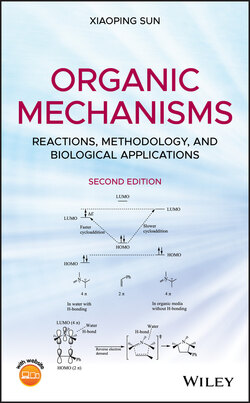Читать книгу Organic Mechanisms - Xiaoping Sun - Страница 21
1.4.3 Rate‐Laws for Stepwise Reactions
ОглавлениеLet us use the following consecutive reaction (Reaction 1.40) that involves both reversible and irreversible elementary processes to demonstrate the general procedure for obtaining rate laws for stepwise reactions [3]:
(1.40)
The rate (r) for the overall reaction can be expressed as an increase in concentration of the product (Z) per unit time (Eq. 1.41):
(1.41)
Since Z is produced only from the k2 step which is a unimolecular process, the rate equation for Z is first order in Y.
The steady‐state assumption is applied to the intermediate Y, and its rate equation is written as follows:
(1.42)
From Equation 1.42, we have
(1.43)
Substituting Equation 1.43 for Equation 1.41 leads to Equation 1.44, the rate law for Reaction 1.40.
(1.44)
where kobs = k1k2/(k−1 + k2) is the observed rate constant.
There are several limiting situations for such a stepwise process [3]. If k2 ≫ k−1 (the intermediate Y is converted to the product Z much faster than going back to the reactant X), Equation 1.44 can be simplified to
In this case, the first step of Reaction 1.40 is the rate‐determining step and actually irreversible.
If k2 ≪ k−1 (the intermediate Y is converted to the product Z much more slowly than going back to the reactant X), there is a fast preequilibrium between the reactant X and the intermediate Y before the product Z is formed. In this case, the Equation 1.44 can be simplified to
where Keq = (k1/k−1) is the equilibrium constant for the fast preequilibrium between X and Y (Keq = [Y]/[X]). Therefore, r = k2[Y], and the second k2 step is the rate‐determining step. Since the fast preequilibrium between X and Y is established prior to the formation of the product, the steady‐state assumption is not necessary if k2 ≪ k−1.
If the values of k2 and k−1 are comparable, the full steady‐state assumption is needed to establish the rate equation as shown in Equation 1.44.
